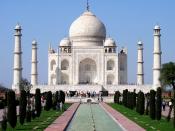The Liberal Artisan in the Global Village
Miss Universe Australia- Jennifer Hawking ran away with the coveted beauty title in a brocade gown; a $25,000 gold creation by Sydney designer Bora at the grand finale; the gown was all Zari, Rs 45 a meter, with value addition and made in our very own Gurgaon. Now that's globalisation!
Is the handicrafts sector in India going down the path of no survival? I started this paper with this question as our principal query. This paper intends to investigate if Globalisation has impeded or helped the growth of the handicrafts industry; using a case study to analyze organizational, market and social changes over a specified period of time i.e. Pre and post liberalisation in India.
India ushered in economic liberalisation in 1991 .It is popular perception that liberalisation has affected the informal handicraft sector adversely; this however I found out has not been the case.
Our methodology involved a four-pronged analysis of the handicrafts sector. I sought to understand what exactly constitutes the definition of a handicraft wherefrom I investigated how the demand for these products has changed, what the governments take is, what the reality of the artisans involved with inputs from 'designers' and finally export house opinion as Ill.
I chose to limit our data set from the 60s to 2004, which I felt reflects a sufficient period to monitor the impact of globalisation on this sector in terms of the time before the 91 reforms and post the 91 reforms.
History
In November 1952, the government of India set up the "All India Handicrafts Board" (AIHB) to channelise the talent of the sector that till today employs the second largest labour next only to agriculture. Today the IAHB has been taken over by the Handicrafts Ministry a division of...


